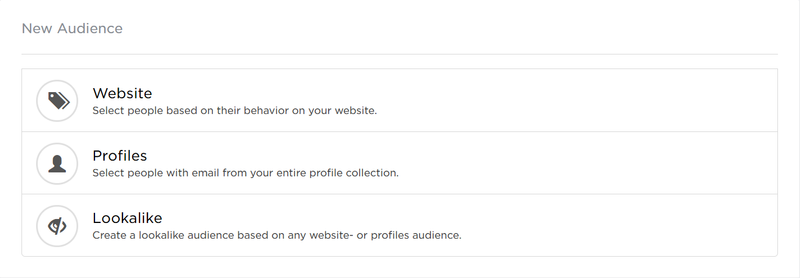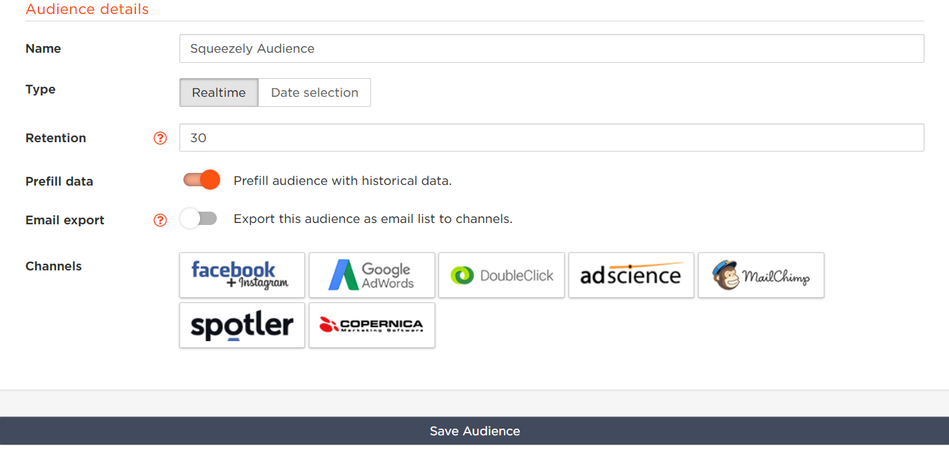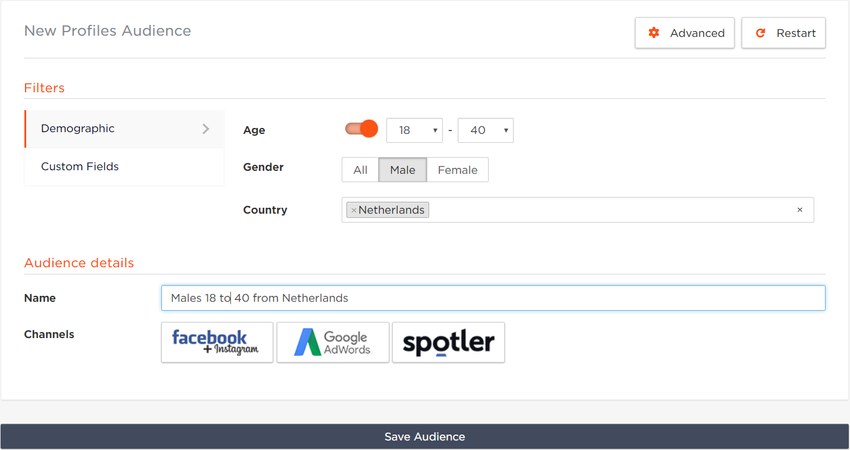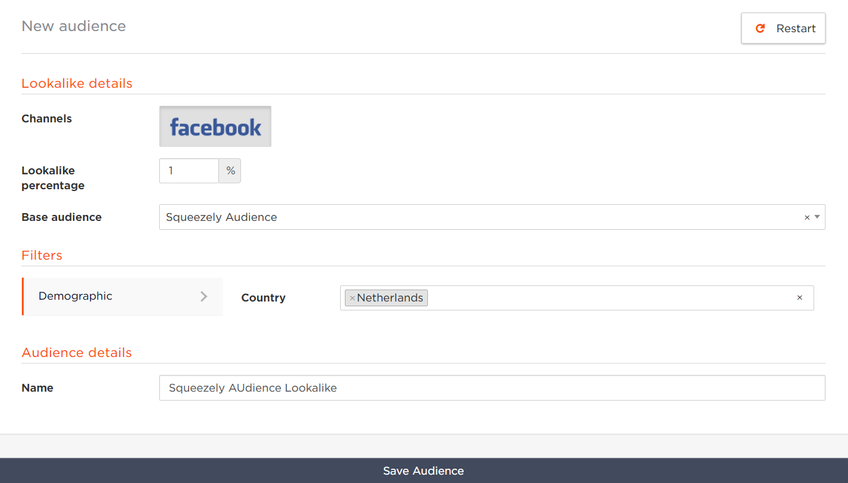- Created by Tim Hoefnagel, last modified on Jan 03, 2019
-
 Interlingo
Interlingo
You are viewing an old version of this page. View the current version.
Compare with Current View Page History
« Previous Version 18 Current »
Audience Builder: How to create an Audience?
This guide will help you understand and build different types of audiences available in Squeezely Platform.
Audience Types
Access Squeezely Audiences under Data > Audiences or start building directly by clicking here.
When you start building an audience in Squeezely, you can choose from three different audience types. Each type is explained below the image.

Website Audience
Select users based on their behavior on your website. You can make selections based on the events you have been sending us and filter these with (custom) fields that have been sent along with those events. Selections can also be filtered based on sources, f.e. the campaign or channel a user has visited your site from.
Profiles Audience
Select users based on fields associated with their profiles, f.e. their birth date or a last arrival date in your hotel. Selections you make here are limited to those profiles that contain an email address, as this is the only way to reach them on external channels.
Lookalike Audience
Each audience you create on Squeezely platform is eligible to create a lookalike audience for Facebook. Lookalikes for Google can only be created using event based audiences.
Where can I use my Audiences?
Below table shows which channels are compatible with each type of Squeezely Audience.
| Channel | Website | Profiles | Lookalike |
|---|---|---|---|
| Yes | Yes | Yes | |
| Google Adwords | Yes | Yes | Yes |
| Display Platforms (DSP) | Yes | No | No |
Email Platforms | Yes | Yes | No |
| Website | Yes | Yes | No |
Building a Website Audience
After selecting website audience from our menu, you will be able to select from different types of filters that will segment your data into an audience.
When using filters, below rules apply to your selections:
- Each filter you add to your selection will narrow your selection further down.
- When you are adding multiple criteria into the same input box, users will be added to your audience if any of these criteria have been met.
In below example this will give you the following result:
Users that have triggered the event "Purchase" AND where the product category was "Boots".

If you would have added multiple categories like in the example below, the following result would be given:
Users that have triggered the event : "Purchase" AND where the product category was "Boots" OR "Belts".

Audience Filters
All filters available for website audiences are explained in the table below.
| Category | Filter | Description |
|---|---|---|
Behavioral | Events | These events have been triggered on your website. |
Products | Use this to specify products in relation to your events. For example: AddToCart events containing Levi Jeans 501. | |
| Categories | Use this to specify product categories in relation to your events. For example: AddToCart events containing any product in the category Jeans. | |
| Value | Use this to specify a value for your selection. For example AddToCart events, Category Jeans, between 50 and 150 Euro. | |
Source | sqzl_campaign utm_campaign | Use this to filter on specific tags you have used in URL tracking. For example everyone that has visited your site using www.yoursite.com?utm_campaign=summer. |
sqzl_source | Use this to filter on specific tags you have used in URL tracking. For example everyone that has visited your site using www.yoursite.com?utm_source=facebook. | |
| URL Visited | Use this to filter on specific URL's your customers have visited. For example everyone that has visited your site using www.yoursite.com/secondpage. | |
| Search Keyword | Use this to filter on specific keywords customers have searched for on your website. | |
| Custom Fields | Custom Field | Use this to filter on custom fields your have used in your events or customer profiles. |
Publishing your Audience
Once you have setup your filters, it is time to publish your audience. After carefully thinking of an appropriate name for your audience, there are a couple of settings you will want to make before pressing save.
Realtime
If you select 'Realtime', your audience will be kept up to date by the Squeezely Platform based on your retention period. This means that if you select retention period 30 days, the audience will contain customers that meet your audience filters in the past 30 days.
When you use the switch 'Prefill data' the system will look back to select users that have met your criteria in days already gone by. This makes sure your audience doesn't start empty.
Date selection
If you select 'Date Selection' you will be able to select a fixed period in time in which your event filters should have been met. For example everyone that matches my criteria between January 1st 2018 up to January 31st in 2018.
Export Method
By default website audiences are exported to external channels as a set of rules. This means your audience will be generated by the external marketing platform based on their own matching standards, often allowing for high match rates.
In the case that your selection contains events you have sent through our API, or if you use custom fields using a 'last known value', we will change your export type to an email based export. This means a list of customer emails will be uploaded to the external platforms you are using. This will often cause your match rate to drop, as this will depend on the amount of email addresses know in your database that can be matched by the external platform.
Turning on the email export switch manually will force the export type to a list of emails. When exporting a list to an Email Service Provider, it will always be an email based export.
Channels
Last step is to select the channels you will be exporting your audience to. Simply click on the logo of the platform you are exporting to and press save. This will start exporting your audience and you will soon find it ready to use on the platform you have selected.

Building a Profiles Audience
Segment your profile database, based on fields that are stored on your users profile card. These are mostly fields that contain only one value that never changes (f.e. a birth date) or fields that are overwritten each time they are updated (f.e. a loyalty status). A profile audience will find all the people that match the criteria you have selected and put them into a segment.
Below example shows you how to export people based on demographic criteria you might have collected in your database. In this example all your profiles with an age between 18 and 40, that are males and are from The Netherlands will be selected.

Publishing your Audience
Export Method
Profiles audiences are exported as an email list. This means a list of emails is uploaded to the external platforms you have selected.
Channels
Select the channels you want to export your audience to by clicking their respective logo's.
When all your settings are made, press 'Save Audience' and Squeezely will start exporting your audience to where you want to use it.
Building a Lookalike Audience
Lookalike audiences are a great way to attract new customers. Any Squeezely audience can be used as the base audience to find lookalikes.
To create a lookalike based on a Squeezely Audience, first you need to have a base audience. Find out more about building audiences here.
How are lookalikes audiences created?
To find lookalikes to your own customers you depend on data that is owned by Facebook or Google. Basically you tell one of these platforms which group of customers is relevant to you and ask them to find people similar to that group. Subsequently Facebook or Google will use all the data they own to create a list of similar profiles. This list can then be targeted by you within their platform.
Creating a lookalike for Facebook using Squeezely Audiences
Go to Data > Audiences and create a new audience. Choose the option 'lookalike'. This will show you the screen below.
Lookalike percentage
Choose a setting from 1% up to 10%. This represents the percentage of Facebook users, within your selected country, most similar to your audience. The bigger the percentage, the bigger your audience will get. However this also means your audience will get less relevant.
Base Audience
This is where you select any audience you have previously created in Squeezely. People in your lookalike audience will be similar to the customers in this selected audience.
Country
Your lookalike audience will contain people from this country.
Where do I find my Lookalike Audience in Facebook?
Within Facebook Business manager, access your Audiences. Your lookalike audiences can be found here.
Alternatively you can use your audience by creating a campaign directly from Squeezely.

Creating a lookalike for Google Adwords using Squeezely Audiences
For each event based audience you create in Squeezely, a looklike audience is automatically created by Google. You will find this in your account within 'Shared Library > Audiences' under the name 'Similar Audience'.
Search
Navigate
Want to find info about a specific feature? Check out these topics below!
- No labels